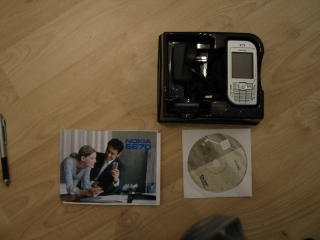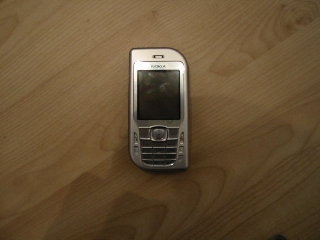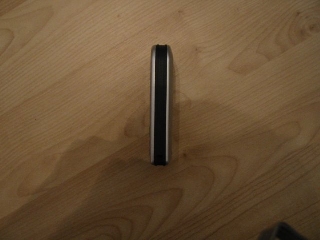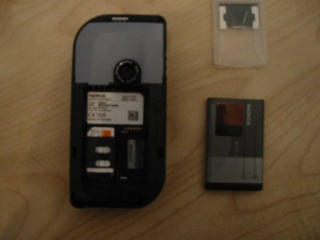 The 6670 is one of the new releases, and is actually in the shops now for around £325 without a contract. It is the successor to the 6600 and bears a striking resemblance to the 7610, but without the quirky keypad. I don't know about anyone else, but I'm completely confused by Nokia's naming conventions, but I guess when you release as many phones as they do, it's difficult to come up with sensible names.
The 6670 is one of the new releases, and is actually in the shops now for around £325 without a contract. It is the successor to the 6600 and bears a striking resemblance to the 7610, but without the quirky keypad. I don't know about anyone else, but I'm completely confused by Nokia's naming conventions, but I guess when you release as many phones as they do, it's difficult to come up with sensible names.
The packaging on the 6670 is the, what now appears to be, standard Nokia sized box, with everything packed neatly away and covered with acres of plastic, I know I'm sad, but I like opening these boxes and finding everything neatly laid out like that, I just think if they go to that much trouble with the packaging, the product is going to be amazing!
The 6670 certainly lives up to it's packaging, and produces a much better first impression than the old 6600 did, it's sleek silver case and clear plastic keypad looks really good, and once you have managed to pull the sticky protector off, the 65k screen looks very clear and bright. Compared with the 6260, the 6670 seems almost bare, apart from the standard Nokia connector on the bottom and a power switch at the top, the sides are completely free of any buttons or switches. This does give it a very stylish look; the only other blemish on its smooth case is the 3.7mm lens for the camera situated on the back. Iím not sure about the shape though, itís miles better than the bulbous look of the 6600, but it reminds me of the exclamation marks Vodafone use in their adverts!
 †
†
To fit the 900mAh battery you unlatch the rear cover, which along with the front is changeable, so you can personalise your phone if you so wish. Under the battery we find one of my pet hates, unlike the 6260, Nokia have taken a step back and hidden the RS-MMC memory card beneath the battery, which means you have to power the phone off every time you want to swap cards. Now you may think this is a trivial complaint, but this phone is billed as a multimedia device, and having to switch it off every time you want to put some new music on the card is a real pain. Yes you can transfer it by Bluetooth, but frankly, I have better things to do with my time!
 Once powered up, you are presented with the standard Series 60 screens, with all the usual applications in place, including the new Presence and positioning tools from Nokia. There are one or two extras that are worth mentioning that set this phone apart from the crowd and a couple that seem to be a complete waste of time. In the former category is a complete set of Office viewers in the form of QuickOffice, not the full program which allows editing, just the file viewers, but a step up from the 6260 in that an Excel viewer is included along with Word and PowerPoint, I never understood why this wasn't on the 6260 as it is very useful if people are in the habit of emailing you worksheets. All three viewers find attachments sent to you in e-mails, and with a bit of jiggling you can view documents transferred to the phone via the PC link as well. Another useful addition is the NetFusion Web Browser, which seemed to do a pretty good job of rendering pages on the sites I tried, but what happened to Opera? I thought this was going to be on all Series 60 phones. All of these comms related programs are no good if you can't get connected to the Internet, so it's nice to see Nokia thinking of the users and including a Settings Wizard that checks your Sim card to see what network you are on then goes away and sets the phone up for MMS, SMS, Web and Wap access, along with the settings for e-mail. This is a big step forward, and should make life a lot easier for first time users. Full marks to Nokia.
Once powered up, you are presented with the standard Series 60 screens, with all the usual applications in place, including the new Presence and positioning tools from Nokia. There are one or two extras that are worth mentioning that set this phone apart from the crowd and a couple that seem to be a complete waste of time. In the former category is a complete set of Office viewers in the form of QuickOffice, not the full program which allows editing, just the file viewers, but a step up from the 6260 in that an Excel viewer is included along with Word and PowerPoint, I never understood why this wasn't on the 6260 as it is very useful if people are in the habit of emailing you worksheets. All three viewers find attachments sent to you in e-mails, and with a bit of jiggling you can view documents transferred to the phone via the PC link as well. Another useful addition is the NetFusion Web Browser, which seemed to do a pretty good job of rendering pages on the sites I tried, but what happened to Opera? I thought this was going to be on all Series 60 phones. All of these comms related programs are no good if you can't get connected to the Internet, so it's nice to see Nokia thinking of the users and including a Settings Wizard that checks your Sim card to see what network you are on then goes away and sets the phone up for MMS, SMS, Web and Wap access, along with the settings for e-mail. This is a big step forward, and should make life a lot easier for first time users. Full marks to Nokia.
In the not so useful category, we have video and photo editing programs, and Nokia's Lifeblog application, none of which offered anything worth mentioning and seem a strange addition on what is supposed to be a business orientated tool. I suppose it might be useful to be able to edit a picture you have just taken, but the options are limited: - lighten, darken, crop and add text is about the extent of the options.
In day to day use the phone performed well, the keypad is not so easy to use as the 6260, as the keys are much smaller, but the navigation pads is much better, especially for gaming. The battery life is good, it easily lasted five days on standby, and as with the 6260, recharges every 3/4 days of reasonably heavy is the norm. The phone ships with Nokia's PC Suite, which allows managing the phone from a PC and synchronising PIM data. Once again, full marks to Nokia, their PC Suite has gone from strength to strength, and is now an ideal way of managing your phone.

I've left the biggest difference between this phone and other Series 60ís to last. Nokia have equipped it with a 1-mega-pixel camera, which also has a 4x zoom. I have to say that the quality of pictures when viewed on the phone is outstanding; you can see the difference over a VGA system immediately. However, as soon as you transfer the pictures to a PC you realise that any phone camera is going to have severe limitations, it's not just the amount of pixels that determine a good camera, it's as much to do with the size and quality of the optics, and any camera phone is going to suffer here. See the comparison pictures above to get some idea of what I mean. For taking quick snaps and sending them to your mates, a VGA system is more than adequate as it uses much less storage and is far cheaper to send via GPRS. There is nothing wrong with the camera in the 6670; I'm just not sold on the idea of more pixels without improving the rest of the camera as well. The video function allows a much longer time for recording than the 6260, but again the videos are really only any good viewed on the phone, once transferred to a bigger screen, they are hopeless.
The 6670 is a good phone, it's a worthy successor to the 6600, and with its ability to read Office attachments straight out of the box, it's a good bet for business users, but I still think the 6260 has the edge. For me the mega-pixel camera is no big deal and I much prefer the clamshell form factor, so the 6260 is still the best in my view. One thingís for sure though, at the rate Nokia is releasing new phones, it wonít be long before something else comes along to threaten its position at the top of my list.
